Dilin Wang
SteinDreamer: Variance Reduction for Text-to-3D Score Distillation via Stein Identity
Dec 31, 2023



Abstract:Score distillation has emerged as one of the most prevalent approaches for text-to-3D asset synthesis. Essentially, score distillation updates 3D parameters by lifting and back-propagating scores averaged over different views. In this paper, we reveal that the gradient estimation in score distillation is inherent to high variance. Through the lens of variance reduction, the effectiveness of SDS and VSD can be interpreted as applications of various control variates to the Monte Carlo estimator of the distilled score. Motivated by this rethinking and based on Stein's identity, we propose a more general solution to reduce variance for score distillation, termed Stein Score Distillation (SSD). SSD incorporates control variates constructed by Stein identity, allowing for arbitrary baseline functions. This enables us to include flexible guidance priors and network architectures to explicitly optimize for variance reduction. In our experiments, the overall pipeline, dubbed SteinDreamer, is implemented by instantiating the control variate with a monocular depth estimator. The results suggest that SSD can effectively reduce the distillation variance and consistently improve visual quality for both object- and scene-level generation. Moreover, we demonstrate that SteinDreamer achieves faster convergence than existing methods due to more stable gradient updates.
EfficientSAM: Leveraged Masked Image Pretraining for Efficient Segment Anything
Dec 01, 2023Abstract:Segment Anything Model (SAM) has emerged as a powerful tool for numerous vision applications. A key component that drives the impressive performance for zero-shot transfer and high versatility is a super large Transformer model trained on the extensive high-quality SA-1B dataset. While beneficial, the huge computation cost of SAM model has limited its applications to wider real-world applications. To address this limitation, we propose EfficientSAMs, light-weight SAM models that exhibits decent performance with largely reduced complexity. Our idea is based on leveraging masked image pretraining, SAMI, which learns to reconstruct features from SAM image encoder for effective visual representation learning. Further, we take SAMI-pretrained light-weight image encoders and mask decoder to build EfficientSAMs, and finetune the models on SA-1B for segment anything task. We perform evaluations on multiple vision tasks including image classification, object detection, instance segmentation, and semantic object detection, and find that our proposed pretraining method, SAMI, consistently outperforms other masked image pretraining methods. On segment anything task such as zero-shot instance segmentation, our EfficientSAMs with SAMI-pretrained lightweight image encoders perform favorably with a significant gain (e.g., ~4 AP on COCO/LVIS) over other fast SAM models.
Drag View: Generalizable Novel View Synthesis with Unposed Imagery
Oct 05, 2023



Abstract:We introduce DragView, a novel and interactive framework for generating novel views of unseen scenes. DragView initializes the new view from a single source image, and the rendering is supported by a sparse set of unposed multi-view images, all seamlessly executed within a single feed-forward pass. Our approach begins with users dragging a source view through a local relative coordinate system. Pixel-aligned features are obtained by projecting the sampled 3D points along the target ray onto the source view. We then incorporate a view-dependent modulation layer to effectively handle occlusion during the projection. Additionally, we broaden the epipolar attention mechanism to encompass all source pixels, facilitating the aggregation of initialized coordinate-aligned point features from other unposed views. Finally, we employ another transformer to decode ray features into final pixel intensities. Crucially, our framework does not rely on either 2D prior models or the explicit estimation of camera poses. During testing, DragView showcases the capability to generalize to new scenes unseen during training, also utilizing only unposed support images, enabling the generation of photo-realistic new views characterized by flexible camera trajectories. In our experiments, we conduct a comprehensive comparison of the performance of DragView with recent scene representation networks operating under pose-free conditions, as well as with generalizable NeRFs subject to noisy test camera poses. DragView consistently demonstrates its superior performance in view synthesis quality, while also being more user-friendly. Project page: https://zhiwenfan.github.io/DragView/.
TODM: Train Once Deploy Many Efficient Supernet-Based RNN-T Compression For On-device ASR Models
Sep 05, 2023



Abstract:Automatic Speech Recognition (ASR) models need to be optimized for specific hardware before they can be deployed on devices. This can be done by tuning the model's hyperparameters or exploring variations in its architecture. Re-training and re-validating models after making these changes can be a resource-intensive task. This paper presents TODM (Train Once Deploy Many), a new approach to efficiently train many sizes of hardware-friendly on-device ASR models with comparable GPU-hours to that of a single training job. TODM leverages insights from prior work on Supernet, where Recurrent Neural Network Transducer (RNN-T) models share weights within a Supernet. It reduces layer sizes and widths of the Supernet to obtain subnetworks, making them smaller models suitable for all hardware types. We introduce a novel combination of three techniques to improve the outcomes of the TODM Supernet: adaptive dropouts, an in-place Alpha-divergence knowledge distillation, and the use of ScaledAdam optimizer. We validate our approach by comparing Supernet-trained versus individually tuned Multi-Head State Space Model (MH-SSM) RNN-T using LibriSpeech. Results demonstrate that our TODM Supernet either matches or surpasses the performance of manually tuned models by up to a relative of 3% better in word error rate (WER), while efficiently keeping the cost of training many models at a small constant.
Mixture-of-Supernets: Improving Weight-Sharing Supernet Training with Architecture-Routed Mixture-of-Experts
Jun 08, 2023



Abstract:Weight-sharing supernet has become a vital component for performance estimation in the state-of-the-art (SOTA) neural architecture search (NAS) frameworks. Although supernet can directly generate different subnetworks without retraining, there is no guarantee for the quality of these subnetworks because of weight sharing. In NLP tasks such as machine translation and pre-trained language modeling, we observe that given the same model architecture, there is a large performance gap between supernet and training from scratch. Hence, supernet cannot be directly used and retraining is necessary after finding the optimal architectures. In this work, we propose mixture-of-supernets, a generalized supernet formulation where mixture-of-experts (MoE) is adopted to enhance the expressive power of the supernet model, with negligible training overhead. In this way, different subnetworks do not share the model weights directly, but through an architecture-based routing mechanism. As a result, model weights of different subnetworks are customized towards their specific architectures and the weight generation is learned by gradient descent. Compared to existing weight-sharing supernet for NLP, our method can minimize the retraining time, greatly improving training efficiency. In addition, the proposed method achieves the SOTA performance in NAS for building fast machine translation models, yielding better latency-BLEU tradeoff compared to HAT, state-of-the-art NAS for MT. We also achieve the SOTA performance in NAS for building memory-efficient task-agnostic BERT models, outperforming NAS-BERT and AutoDistil in various model sizes.
PathFusion: Path-consistent Lidar-Camera Deep Feature Fusion
Dec 12, 2022Abstract:Fusing camera with LiDAR is a promising technique to improve the accuracy of 3D detection due to the complementary physical properties. While most existing methods focus on fusing camera features directly with raw LiDAR point clouds or shallow 3D features, it is observed that direct deep 3D feature fusion achieves inferior accuracy due to feature misalignment. The misalignment that originates from the feature aggregation across large receptive fields becomes increasingly severe for deep network stages. In this paper, we propose PathFusion to enable path-consistent LiDAR-camera deep feature fusion. PathFusion introduces a path consistency loss between shallow and deep features, which encourages the 2D backbone and its fusion path to transform 2D features in a way that is semantically aligned with the transform of the 3D backbone. We apply PathFusion to the prior-art fusion baseline, Focals Conv, and observe more than 1.2\% mAP improvements on the nuScenes test split consistently with and without testing-time augmentations. Moreover, PathFusion also improves KITTI AP3D (R11) by more than 0.6% on moderate level.
Fast Point Cloud Generation with Straight Flows
Dec 04, 2022



Abstract:Diffusion models have emerged as a powerful tool for point cloud generation. A key component that drives the impressive performance for generating high-quality samples from noise is iteratively denoise for thousands of steps. While beneficial, the complexity of learning steps has limited its applications to many 3D real-world. To address this limitation, we propose Point Straight Flow (PSF), a model that exhibits impressive performance using one step. Our idea is based on the reformulation of the standard diffusion model, which optimizes the curvy learning trajectory into a straight path. Further, we develop a distillation strategy to shorten the straight path into one step without a performance loss, enabling applications to 3D real-world with latency constraints. We perform evaluations on multiple 3D tasks and find that our PSF performs comparably to the standard diffusion model, outperforming other efficient 3D point cloud generation methods. On real-world applications such as point cloud completion and training-free text-guided generation in a low-latency setup, PSF performs favorably.
Multi-Scale High-Resolution Vision Transformer for Semantic Segmentation
Nov 23, 2021
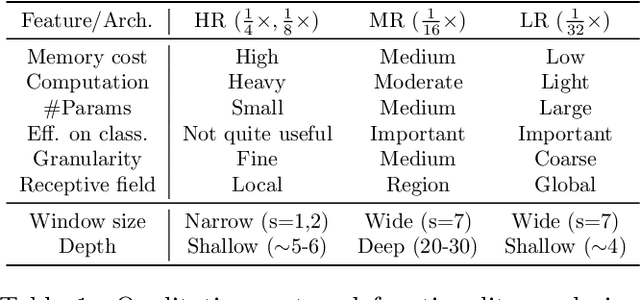
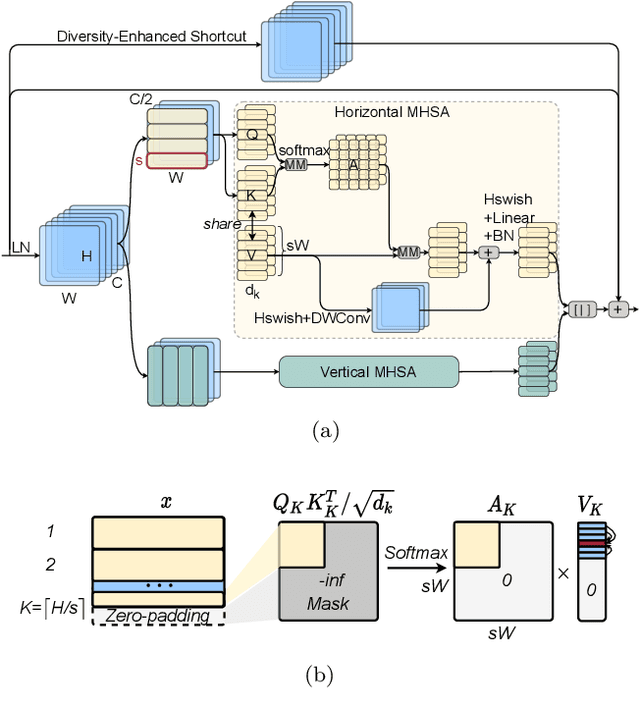
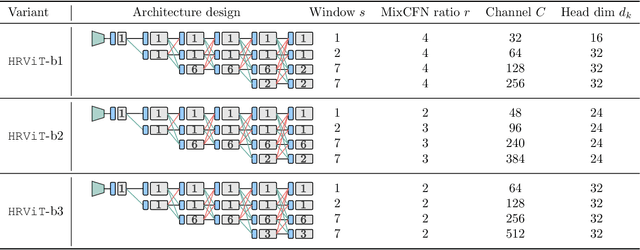
Abstract:Vision Transformers (ViTs) have emerged with superior performance on computer vision tasks compared to convolutional neural network (CNN)-based models. However, ViTs are mainly designed for image classification that generate single-scale low-resolution representations, which makes dense prediction tasks such as semantic segmentation challenging for ViTs. Therefore, we propose HRViT, which enhances ViTs to learn semantically-rich and spatially-precise multi-scale representations by integrating high-resolution multi-branch architectures with ViTs. We balance the model performance and efficiency of HRViT by various branch-block co-optimization techniques. Specifically, we explore heterogeneous branch designs, reduce the redundancy in linear layers, and augment the attention block with enhanced expressiveness. Those approaches enabled HRViT to push the Pareto frontier of performance and efficiency on semantic segmentation to a new level, as our evaluation results on ADE20K and Cityscapes show. HRViT achieves 50.20% mIoU on ADE20K and 83.16% mIoU on Cityscapes, surpassing state-of-the-art MiT and CSWin backbones with an average of +1.78 mIoU improvement, 28% parameter saving, and 21% FLOPs reduction, demonstrating the potential of HRViT as a strong vision backbone for semantic segmentation.
Temporally Consistent Online Depth Estimation in Dynamic Scenes
Nov 17, 2021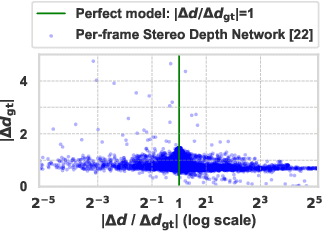



Abstract:Temporally consistent depth estimation is crucial for real-time applications such as augmented reality. While stereo depth estimation has received substantial attention that led to improvements on a frame-by-frame basis, there is relatively little work focused on maintaining temporal consistency across frames. Indeed, based on our analysis, current stereo depth estimation techniques still suffer from poor temporal consistency. Stabilizing depth temporally in dynamic scenes is challenging due to concurrent object and camera motion. In an online setting, this process is further aggravated because only past frames are available. In this paper, we present a technique to produce temporally consistent depth estimates in dynamic scenes in an online setting. Our network augments current per-frame stereo networks with novel motion and fusion networks. The motion network accounts for both object and camera motion by predicting a per-pixel SE3 transformation. The fusion network improves consistency in prediction by aggregating the current and previous predictions with regressed weights. We conduct extensive experiments across varied datasets (synthetic, outdoor, indoor and medical). In both zero-shot generalization and domain fine-tuning, we demonstrate that our proposed approach outperforms competing methods in terms of temporal stability and per-frame accuracy, both quantitatively and qualitatively. Our code will be available online.
Omni-sparsity DNN: Fast Sparsity Optimization for On-Device Streaming E2E ASR via Supernet
Oct 15, 2021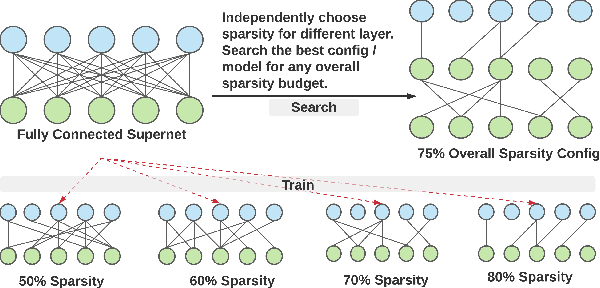
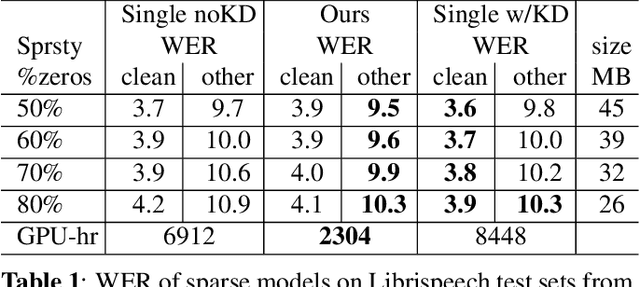

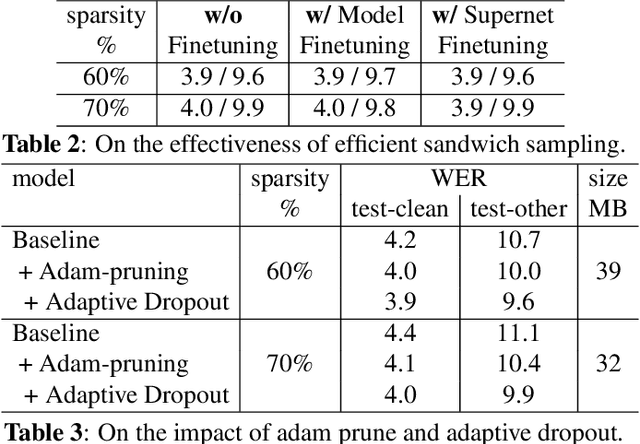
Abstract:From wearables to powerful smart devices, modern automatic speech recognition (ASR) models run on a variety of edge devices with different computational budgets. To navigate the Pareto front of model accuracy vs model size, researchers are trapped in a dilemma of optimizing model accuracy by training and fine-tuning models for each individual edge device while keeping the training GPU-hours tractable. In this paper, we propose Omni-sparsity DNN, where a single neural network can be pruned to generate optimized model for a large range of model sizes. We develop training strategies for Omni-sparsity DNN that allows it to find models along the Pareto front of word-error-rate (WER) vs model size while keeping the training GPU-hours to no more than that of training one singular model. We demonstrate the Omni-sparsity DNN with streaming E2E ASR models. Our results show great saving on training time and resources with similar or better accuracy on LibriSpeech compared to individually pruned sparse models: 2%-6.6% better WER on Test-other.
 Add to Chrome
Add to Chrome Add to Firefox
Add to Firefox Add to Edge
Add to Edge